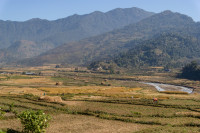Opinion
Measure for measure
The arguements on Nepal’s low agricultural productivity offered by USAID are debatable
Anil Bhattarai
Nepal’s agriculture development paradigm is based on an erroneous understanding of agricultural productivity, the results of which have been distorted priorities and missed opportunities. A better path forward is to move from crop-specific productivity towards total farm productivity.
Agriculture incongruities
In her essay (‘Seeds that give,’ January 14, Page 7), Beth Dunford, current Mission Director of the United States Agency for International Development’s (USAID) Nepal office, has spelled out the US government’s vision for helping Nepal achieve a lot of things. Among them are 1) “to fulfil Nepal’s food supply needs”; 2) to take agriculture to a commercial scale; 3) to improve nutrition; and 4) to achieve growth. She chronicles the various initiatives that USAID has been supporting in Nepal in the area of seed production and farmers’ empowerment. The essay, which reads more like project promotion material than a coherently argued piece of writing, was published in the aftermath of Chaudhary Group’s Monsanto ‘oops’ moment. It is not mere coincidence then that Dunford clarifies in her essay that USAID’s Feed the Future programme does not come with a condition of accepting genetically engineered seeds.
However, one cannot help noticing some incongruities in her essay. For instance, we have no clue how producing maize for Nepal’s burgeoning feed industry contributes to enhancing nutrition security or helps fulfil “Nepal’s food supply needs.” Nor can we easily reconcile the contradiction between promoting hundreds of seed-producers groups alongside hybrid seeds produced by multinational companies. What will happen to the business of the former if hybrid seeds take over, for instance? For now, let’s keep these points aside.
There is a bigger issue at stake. Dunford’s essay, like a vast majority of writing on Nepal’s agricultural problems, is premised upon one seemingly incontrovertible truth: the low-productivity of Nepal’s agriculture. But the discussion about agricultural productivity is often marred by a conflation among the different ways productivity is measured.
Calculating productivity
In agriculture, there are three major ways of calculating productivity. First, you can calculate productivity of specific crops in terms of total output per unit area of land. This is called crop productivity. Second, you can calculate the productivity of labour in terms of the share of output per unit of labour. This is called labour productivity. Third, you can calculate the total amount of products per unit of land under farming. This is called total farm productivity.
Very often, these three are conflated to make all kinds of statements. In countries where farmers produce one or two specialised commodity crops, crop productivity and farm productivity might very often overlap significantly.
But most Nepali farms are polycultures, meaning they produce multiple products. Within a given year, most of the farms in Nepal produce grains, vegetables, fruits, fodder, firewood, animals and herbs, to name a few. I have scanned research reports and journal publications and talked to many agricultural experts to discover the extent of research on farm productivity. It appears that during the last six-plus decades of Nepal’s agricultural modernisation, there has not been a single serious study of total farm productivity. Most agriculture research is very specialised, focussing only on a very small part of farming. A few researches claim to be farm system research, but upon closer examination, it becomes clear that almost all of them are crop system research.
Between 1977 and 2009, the Institute of Agriculture and Animal Sciences (IAAS), a college of agriculture under Tribhuvan University, published 478 research papers in its IAAS Journal. In the first issue of that journal, there was one essay that compared small farms in Lamjung and Chitwan in terms of the average size of landholding, the crops grown and livestock kept. All the rest dealt with specialised topics such as pesticide efficacy, crop productivity and crop diseases, among others. Let’s accept it, when it comes to the condition of actual farm productivity, Nepal’s agricultural experts have almost no clue.
Chasing crows
There is a saying in Nepali: “Kaag le kaan lagyo bhandaima kaan chamne ki kaagko pachi dagurne? (If someone told you that a crow has plucked your ear, would you feel for your ear first or run after the crow?)”. It seems that when it comes to discussions on agricultural productivity in Nepal, we are running after the crow instead of feeling for our ear first. In the early 1950s, a bunch of agricultural experts from the US came to Nepal and told us that our agriculture needed to change because it was unproductive. Then, thousands of Nepalis trained in agricultural sciences and repeated the same thing the American experts had said. Politicians copycatted these experts and journalists got their quotes and bytes from them. For the last six-plus decades, we have heard the same story again and again. But we have not paused to seriously ask: what measure of productivity did we use to gauge our agricultural productivity?
As I have spelled out in many of my previous columns, thousands of farmers across Nepal have created highly productive and ecologically integrated farms. Learning from them will be the crucial first step in enhancing Nepal’s agricultural productivity. As important as it is, taking stock of total farm productivity and identifying ways of enhancing it is also limited to addressing many agricultural woes in Nepal. For instance, the privatisation of health care and education has led to escalating household expenses. A routine visit to the doctor often costs the equivalent of several months’ agricultural produce. The sale of assets is common during distress illnesses. Addressing these issues requires going beyond the ‘agricultural sector.’ More about this in my next essay.
Bhattarai is working on a PhD dissertion on ecological farming practices in Nepal.He has been on a break from his long-runing Post column ‘(un)commonsense’




 8.12°C Kathmandu
8.12°C Kathmandu










